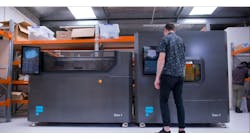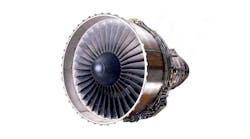Recently, a manufacturer of steel parts that weigh up to 3,000 lbs. (and larger) asked Vulcan Engineering Co. to improve the heavy grinding in its finishing operation. Vulcan designed and built a robotic grinding cell, centered on a foundry-duty robot together with measurement and software technologies to handle the dimensional variations inherent in the customer’s process. The cell’s key features are:
• Heavy-duty load/unload turntable to introduce the part with minimal interruption of operation;
• Servo-driven 2-axis part manipulator on each side of turntable;
• Foundry-duty ABB IRB 7600 robot;
• Hydraulic 100hp grinder with manual quick-change of resin bonded wheels;
• Laser measurement for part calibration;
• Wheel measurement and dressing system;
• Vulcan TruPath 3D software for robot path tuning.
Grinding of large and/or heavy parts has always been a formidable task for metalcasters and forgers. Just moving these parts — many weighing thousands of pounds — between processes, or manipulating them for a manual grinder, is a challenge. Grinding these parts typically requires removing large quantities of metal, but due to manual constraints the horsepower of the grinding tool is often limited to what an operator can readily handle. The combination of difficult handling with severe power and pressure limitations results in inefficient, labor-intensive, time-intensive operations.
Another significant problem is the part-to-part and run-to-run dimensional variations inherent in most molding operations for large parts, along with increasingly stringent customer standards for appearance and consistency of the product. For Vulcan, the challenge was to transform this inefficient and ergonomically undesirable scenario into a lean, efficient, consistent process.
A critical part of the solution is a robotic cell designed to grind flash from large steel parts. The extremely heavy flash (at times over an inch thick) and the material properties of this application dictate a high-powered hydraulic grinder and resin bonded abrasive wheels. However, with other materials and processes, electric grinders and “superabrasive” wheels may be used.
Today, robots have high payload capacity and provide consistent performance under load, making them capable of carrying very powerful tools. No longer, then, is the process limited to low-power man-operated tools. Vulcan’s new finishing cell uses a hydraulic grinder powered by a remote- mounted hydrostatic unit with a 100-HP (73-kW) motor. The 6-axis, foundry-duty robot used in the cell, with a capacity of 400 kg, is strong enough to apply the pressure needed to fully utilize the grinder horsepower, as well as the abrasive itself.
Meanwhile, a non-contact sensor periodically measures grinding wheel diameters so the system can automatically compensate for wheel wear. Thus, the robotic system can accurately remove material at a rate many times greater than a human. And, because such heavy material removal translates into relatively frequent grinding wheel changes, the grinder is outfitted with a specially designed spindle/arbor interface so an operator can quickly replace a spent grinding wheel with a fresh one.
For part handling, the system uses a specially designed, multi-axis positioner to load/unload the cell and to manipulate the part in front of the robot. In addition to the main turntable axis used to introduce the part into the cell, each side of the positioner features a horizontal-rotation axis, a hydraulic clamping mechanism and a servo-driven rotation axis for infinite part positioning. The servo axis carries the fixture mount, and is controlled as a seventh axis of the robot so that it can be fully coordinated with the motion of the robot. A universal set of cones holds and clamps all of the cylindrically shaped parts, avoiding tooling cost for a large portion of the product range. Custom-designed fixtures are easily interchanged to support other part shapes. Thus, a part is easily loaded/unloaded by an operator with an overhead crane outside the cell while the robot precisely controls the position of the part inside the cell.
To address dimensional and positional variation of the parts, the system uses a laser sensor to calibrate the robot’s grinding paths automatically based on the actual part in the cell. The sensor is used with the robot and servo axis in search mode to find and measure the split line of the part, then to gather data points in other critical areas. This routine ensures that the grinding actions are performed relative to the actual part, rather than a theoretical set of coordinates. To complement the calibration system, the operator may use Vulcan’s TruPath 3D software to fine-tune robot paths right on the HMI touch-screen. Thus, the system can consistently process parts within prescribed tolerances regardless of normal part variations.
The robotic grinding system allows far greater material removal rates than manual processing while eliminating much of the handling and work-in-process typically associated with unwieldy parts. And, with integrated intelligence calibrating to each part, consistent results are readily achievable even with the dimensional variation inherent in casting processes. Overall productivity and efficiency are typically increased many times over. Hazardous manual grinding and familiar bottlenecks are overcome, making for a leaner and more competitive enterprise.








